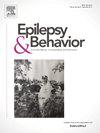Seizure outcomes after cortical stimulation-induced seizures: A systematic review and meta-analysis
IF 2.3
3区 医学
Q2 BEHAVIORAL SCIENCES
引用次数: 0
Abstract
Objective
To perform a systematic review and meta-analysis to evaluate the association between stimulation-induced seizures and favorable surgical outcomes in drug-resistant epilepsy patients.
Methods
A search was conducted using PubMed, Cochrane and Embase databases to identify relevant studies. The prevalence of stimulation-induced seizures and the association between them and favorable surgical outcomes were assessed using a random effects model. A narrative review was also performed. If a patient achieved either Engel I or ILAE class 1 or 2 they were considered to have had a favorable surgical outcome. A minimum of 12 months of follow-up time was required.
Results
Only three studies met criteria to be included in the meta-analysis and over half the patients came from a single study. The pooled prevalence of stimulation-induced seizures was 59.2% (95% CI, 41.5–74.9). There was a trend towards a significant association between stimulation-induced seizures and favorable surgical outcomes in patients who received resection irrespective of stimulation settings, but it did not reach statistical significance (RR: 1.76, 95% CI 0.96–3.23). The narrative review suggested that low frequency stimulation may be less sensitive but more specific compared to high frequency stimulation for producing typical seizures and may be more predictive of surgical outcomes.
Conclusions
Stimulation-induced seizures were not statistically associated with surgical outcomes, but our meta-analysis was limited to a small number of studies and pooled results at both high and low frequency stimulation. Low frequency stimulation induced seizures were more consistently associated with favorable surgical outcomes in patients who had resection compared to high frequency stimulation induced seizures.
皮质刺激诱发癫痫发作后的癫痫结果:系统回顾和荟萃分析
目的通过系统回顾和荟萃分析,评价耐药癫痫患者刺激诱发癫痫发作与手术预后之间的关系。方法检索PubMed、Cochrane和Embase数据库,筛选相关研究。使用随机效应模型评估刺激诱发癫痫发作的发生率及其与良好手术结果之间的关系。还进行了叙述审查。如果患者达到Engel I级或ILAE 1级或2级,则认为他们具有良好的手术结果。至少需要12个月的随访时间。结果只有三项研究符合纳入荟萃分析的标准,超过一半的患者来自单一研究。刺激诱发癫痫发作的总发生率为59.2% (95% CI, 41.5-74.9)。在接受切除的患者中,无论刺激设置如何,刺激诱发癫痫发作与手术预后之间都有显著相关的趋势,但没有达到统计学意义(RR: 1.76, 95% CI 0.96-3.23)。叙述性回顾表明,低频刺激可能不太敏感,但与高频刺激相比,低频刺激产生典型癫痫发作的特异性更强,并且可能更能预测手术结果。结论:刺激诱发的癫痫发作与手术结果无统计学相关性,但我们的荟萃分析仅限于少数研究,并汇集了高频和低频刺激的结果。与高频刺激诱发的癫痫发作相比,低频刺激诱发的癫痫发作更一致地与切除患者的良好手术结果相关。
本文章由计算机程序翻译,如有差异,请以英文原文为准。
求助全文
约1分钟内获得全文
求助全文
来源期刊

Epilepsy & Behavior
医学-行为科学
CiteScore
5.40
自引率
15.40%
发文量
385
审稿时长
43 days
期刊介绍:
Epilepsy & Behavior is the fastest-growing international journal uniquely devoted to the rapid dissemination of the most current information available on the behavioral aspects of seizures and epilepsy.
Epilepsy & Behavior presents original peer-reviewed articles based on laboratory and clinical research. Topics are drawn from a variety of fields, including clinical neurology, neurosurgery, neuropsychiatry, neuropsychology, neurophysiology, neuropharmacology, and neuroimaging.
From September 2012 Epilepsy & Behavior stopped accepting Case Reports for publication in the journal. From this date authors who submit to Epilepsy & Behavior will be offered a transfer or asked to resubmit their Case Reports to its new sister journal, Epilepsy & Behavior Case Reports.
 求助内容:
求助内容: 应助结果提醒方式:
应助结果提醒方式:


